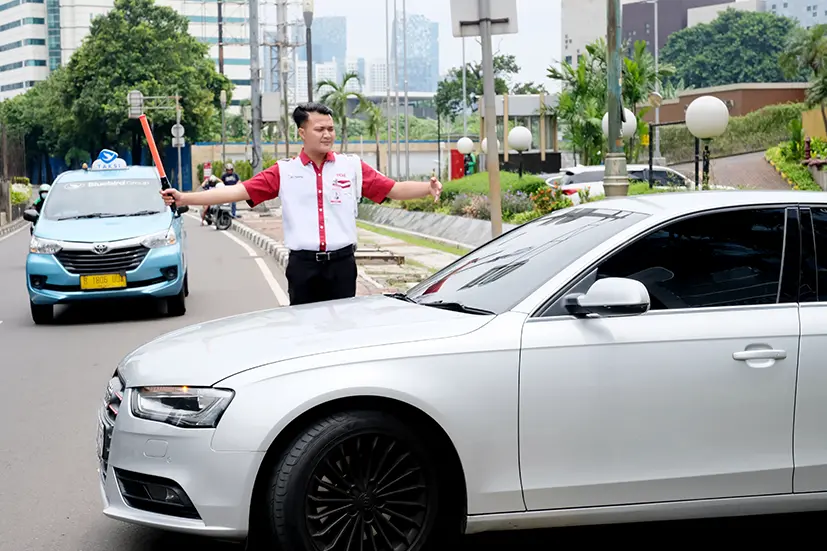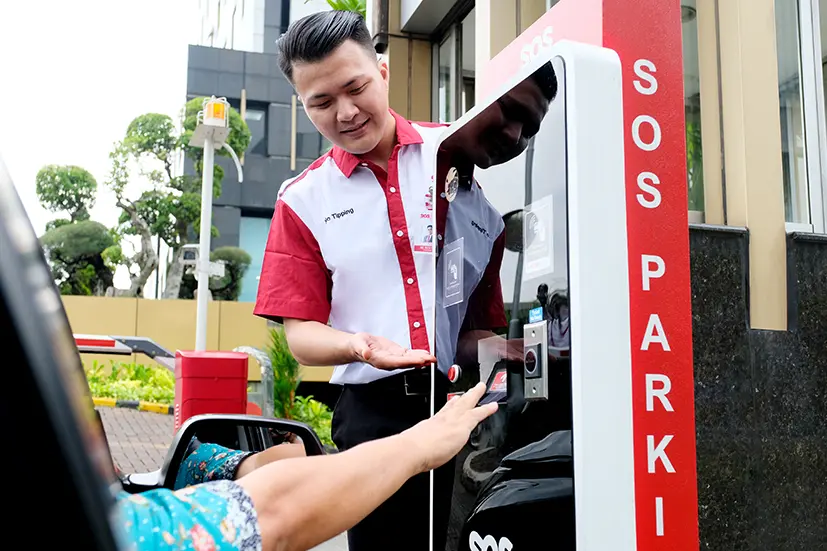Must-Know! Office Security SOP to Keep Assets & Employees Safe
25 August 2025

Maintaining office security is not just about installing CCTV or hiring security guards—it’s about developing a systematic and integrated Standard Operating Procedure (SOP). An office security SOP plays a vital role in creating a safe working environment.
So, what are the common components of an office security SOP, and what does its implementation look like? Let’s dive into the full explanation below.
What is an Office Security SOP?
An office security SOP is a guideline document that outlines the standard procedures all employees must follow to ensure safety and order in the workplace.
In practice, the SOP serves as a reference for all security personnel so they don’t act arbitrarily or based on personal judgment.
For example: how to respond to unknown visitors, what the evacuation protocol should be in case of a fire, or how to report a lost item.
With an SOP in place, everything is clearly defined, eliminating confusion.
Read Also: 10 Standard Operating Procedures for Security Guards
5 Objectives of an Office Security SOP
Why is an office security SOP so important? Here are the main reasons it is crucial for any company:
1. Protecting Physical and Non-Physical Assets
Company assets include office equipment, important documents, IT systems, and sensitive information. A clear SOP ensures all assets are protected against theft, damage, or data breaches.
2. Enhancing Employee Safety
Security is not only about property but also about human lives. SOPs cover disaster response protocols such as fire, earthquake, or emergency evacuation that can save employees’ lives.
3. Ensuring Orderly Operations
With a security SOP, office operations become more structured. Everyone knows their role, when and how to act, and who is responsible in case of security issues.
4. Building Business Partner Trust
Companies with a solid security SOP demonstrate professionalism and integrity. This builds trust with partners, clients, and investors.
5. Ensuring Compliance with Regulations
In industries like finance, manufacturing, or data centers, strict regulations on security apply. SOPs help companies comply with government requirements and international standards.
Read Also: Hospital Security SOP: Essential Protocols for Medical Areas
Key Components of an Office Security SOP
For an office security SOP to work effectively, it should include the following key components:
1. Risk Identification and Analysis
Assess potential threats, whether internal or external—such as fire hazards, insider theft, cyberattacks, natural disasters, or physical threats.
2. Entry and Exit Control Rules
Define who can access the building, guest reception procedures, operating hours, and access controls such as ID cards, visitor logbooks, and metal detectors.
3. Surveillance and Routine Patrols
Set schedules for security patrols, areas to be monitored, and use of security devices like CCTV, alarms, and automated door control systems.
4. Incident Handling and Emergency Response
Outline detailed procedures for incidents like theft, lost items, bomb threats, fires, or floods—including who to contact and how to evacuate.
5. Reporting and Documentation Process
Every security-related incident must be documented. SOPs should specify report formats, recipients, and escalation procedures.
6. Training and Supervision of Security Personnel
Security staff must receive regular training on conflict handling, communication with employees and visitors, and updates on SOPs.
7. Periodic Evaluation and Revision
SOPs must be reviewed regularly to stay relevant with new technologies or organizational changes.
Read Also: 5 Differences Between Satpam and Security: Which One Is More Suitable?
Example of an Effective Office Security SOP
Berikut contoh isi SOP keamanan kantor yang dapat menjadi referensi:
Document Number: SOP-SEC/001
Revision: 01
Effective Date: August 1, 2025
Prepared by: Security & General Affairs Division
Approved by: Head of Office Operations
1. SOP Title
Office Access Control and Building Surveillance SOP
2. Purpose
To establish standard procedures for office access control and area security to ensure a safe, orderly, and professional workplace while minimizing internal and external security risks.
3. Scope
Covers all security activities in the office area, including access control, visitor screening, surveillance of strategic areas, and incident reporting.
4. Definitions
-
Security Officer (Guard): Personnel assigned to perform office security and surveillance.
-
Visitor: Any external party visiting the office, with or without an appointment.
-
Authorized Access Point: Official entry and exit points for employees and visitors.
5. References
-
Law No. 2 of 2002 on the Indonesian National Police
-
Company Security Code of Conduct
6. Responsibilities
-
Head of Security: Ensures implementation and monitoring of the SOP.
-
Security Officers: Follow SOP procedures and report violations or incidents.
-
Employees: Comply with all security rules according to company policies.
7. Work Procedures
7.1. Employee Access Control
-
Employees must use their ID card at automated access gates.
-
Those without an ID card must report to security and sign the manual log.
-
Employees may not open doors for others without authorization.
7.2. Visitor Access Control
-
Visitors must register in the guest logbook or digital system.
-
Visitors must show valid ID (KTP/Driver’s License/Passport).
-
Security confirms with the host employee before entry.
-
Visitors receive a Visitor Badge and must wear it at all times.
-
Visitors may only enter when accompanied by the host employee.
7.3. Baggage Inspection
-
All visitor belongings must be visually inspected and scanned with a metal detector.
-
Suspicious items are not allowed without approval from the Security Manager.
-
Package deliveries must go through designated inspection areas.
7.4. Daily Area Surveillance
-
Security officers must patrol office areas every 2 hours.
-
Key areas include:
-
Server rooms
-
Archive storage
-
Parking lots
-
Emergency exits
-
Public restrooms and back staircases
-
Patrols must be logged in the Security Patrol Log.
7.5. Incident Response
In cases such as theft, fights, or uncooperative visitors:
-
Secure the area immediately.
-
Notify Head of Security and document the incident.
-
Involve the police if the case is criminal in nature.
-
Record all cases in the Security Incident Log and report to management.
7.6. Emergency Evacuation Procedures
-
In the event of fire or disaster:
-
Security activates the alarm and initiates evacuation.
-
Employees proceed to assembly points via evacuation routes.
-
Security ensures no one is left inside the building.
-
Reports are submitted to the Head of Security for further instructions.
8. Supporting Equipment & Forms
-
Employee ID Cards & Visitor Badges
-
Guest Logbook
-
Patrol Log
-
Incident Report Log
-
Handy Talky (HT), flashlight, body camera
-
24-hour CCTV
-
Metal detectors and automated alarms
9. Training & Socialization
-
All security personnel must attend annual training on SOPs and emergency response.
-
New employees must receive a security SOP briefing during onboarding.
-
Evacuation drills must be conducted every 6 months.
10. Evaluation & Revision
-
This SOP is reviewed annually or following major incidents.
-
Revisions are handled by the Security & General Affairs Division and approved by management.
11. Closing
This SOP serves as the primary guideline for maintaining office security and order. Compliance is the responsibility of all employees to create a safe and professional workplace.
Office security should never be taken lightly. Investing in an office security SOP is not just about meeting formalities—it’s about protecting lives, safeguarding assets, and ensuring business continuity.
Therefore, companies need solutions that are not only technically reliable but also professionally integrated.
To establish a professional and standardized office security system, partnering with a trusted outsourcing provider like SOS is the right decision.
Build a Professional Office Security System with Trained Security Guards from SOS!
SOS provides professional office security services with certified security officers trained by the Indonesian National Police.
Our security personnel are trained in:
-
Systematic patrol procedures
-
Quick and precise emergency response
-
Polite yet firm communication principles
-
Operation of modern security equipment
-
Full compliance with office security SOPs
Contact the SOS team via WhatsApp today for a consultation and customized office security solution that meets industry standards!



